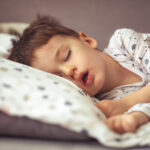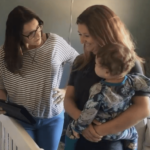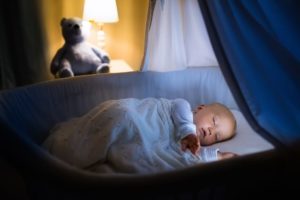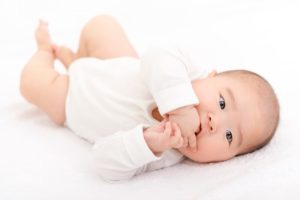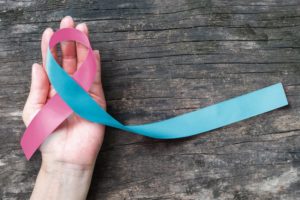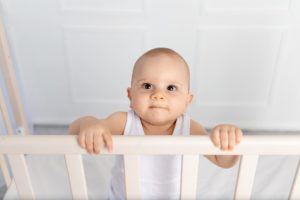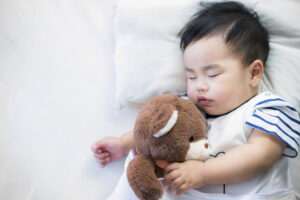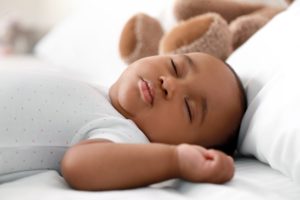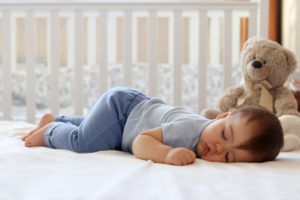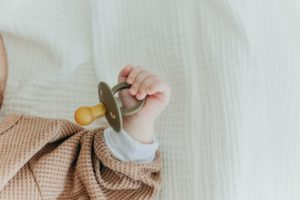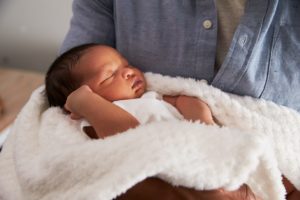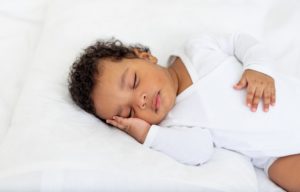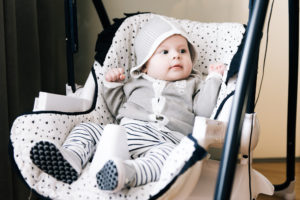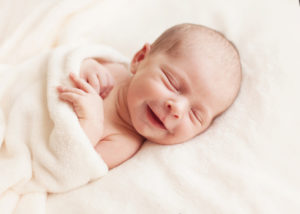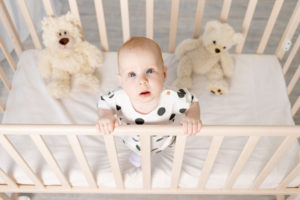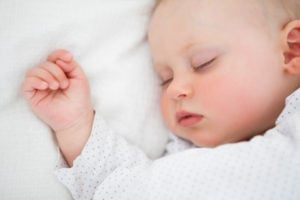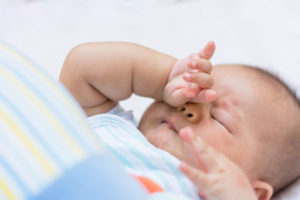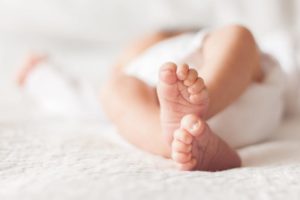When you buy through our links, we may earn a commission. Products or services may be offered by an affiliated entity. Learn more.
Benign Neonatal Sleep Myoclonus
Parents and caregivers of newborn infants know that it can be fascinating to watch babies sleep. However, it can also be stressful when you happen to observe unusual movements. If your baby displays repetitive twitches during sleep, they may have benign sleep myoclonus of infancy, also called benign neonatal sleep myoclonus.
There is limited research on benign neonatal sleep myoclonus. Although episodes can look dramatic, most researchers believe the condition is not harmful. Still, knowing more about this disorder may help set your mind at ease if your infant has been diagnosed with benign neonatal sleep myoclonus.
What Is Benign Neonatal Sleep Myoclonus?
Benign neonatal sleep myoclonus is a sleep-related movement disorder that occurs in very young infants. The condition is characterized by fast, repetitive jerks of large muscles, such as the arms, legs, and torso, during sleep. In contrast to sleepwalking or other disorders that involve movement during sleep, this condition is characterized by simple, repetitive movements that do not appear to be goal-directed.
In benign neonatal sleep myoclonus, myoclonic jerks occur multiple times while the infant is sleeping. The condition is considered harmless, though without measuring brain waves it may be difficult to tell whether an infant has benign neonatal sleep myoclonus or epilepsy.
Help Your Baby Sleep Better With Pediatric Sleep Coaching
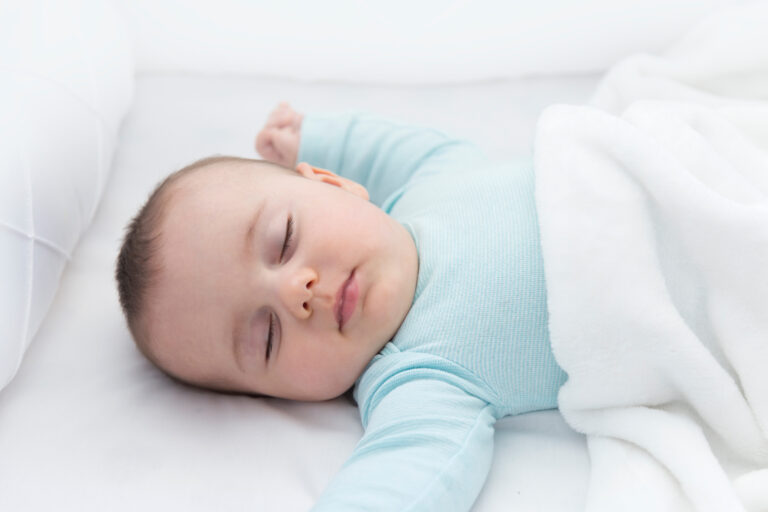
our partner at sleepdoctor.com
Learn More“Life-changing! My anxiety about my son’s sleeping habits were immediately reduced after talking to Sara. She went above and beyond to tailor a schedule to our goals, answer our questions, keep us on track, and check in to encourage us when we just thought we couldn’t do it anymore.”
Rachael B. – Verified Customer
Causes
Researchers are not sure what causes benign neonatal sleep myoclonus. Experts have hypothesized that the movements may occur when the protective sheath around a baby’s spinal cord has not yet fully developed. This situation might trigger the body to carry out impulses that would have otherwise been impeded.
Benign neonatal sleep myoclonus may run in families. For infants who have the disorder, myoclonic jerks may be triggered by repetitive noises or rocking.
Although most cases of benign neonatal sleep myoclonus occur in infants of mothers who do not use drugs, the disorder is common in babies born to mothers with an opioid addiction . More research is needed to understand whether these infants should fall into the same category as those who have benign neonatal sleep myoclonus unrelated to opioid withdrawal, as infants with neonatal opioid withdrawal may require extra care.
Symptoms
Infants with benign neonatal sleep myoclonus display significant involuntary muscle jerks during sleep. These movements most often occur in the arms, legs, or core. Less commonly, they might occur in the face. Myoclonic jerks in benign neonatal sleep myoclonus are usually symmetrical, involving muscle groups on both sides of the body. On occasion, they may involve the whole body.
Researchers have used electroencephalography (EEG) and electromyography (EMG) to investigate brain and muscle activity in babies with benign neonatal sleep myoclonus. The readings indicate that although muscles show twitches like those that occur during a seizure, brain waves in benign neonatal sleep myoclonus do not bear any resemblance to seizures.
Symptoms of benign neonatal sleep myoclonus mostly occur during quiet sleep , which is more or less equivalent to non-rapid eye movement sleep (NREM) in adults. That said, some studies have observed symptoms of benign neonatal sleep myoclonus in all sleep stages . Myoclonic jerks do not appear to be linked to awakenings or transitions between different sleep stages.
Diagnosing Benign Neonatal Sleep Myoclonus
A baby might receive a diagnosis of benign neonatal sleep myoclonus if they meet four criteria:
- The baby displays involuntary and repetitive muscle jerks, termed myoclonus, in the trunk, the arms and legs, or the whole body.
- These movements happen when the baby is very young, usually between birth and 6 months old.
- Myoclonus occurs uniquely during sleep, and it always stops immediately once the infant wakes up.
- The movements cannot be attributed to another factor such as medication use, a neurological condition, or a sleep disorder.
In addition to stopping abruptly when the baby is awoken, myoclonic episodes can also stop on their own while the baby continues sleeping .
Similar Conditions to Benign Neonatal Sleep Myoclonus
Benign neonatal sleep myoclonus may appear similar to myoclonic seizures. The key difference is that for infants with benign neonatal sleep myoclonus, the myoclonic jerks never occur when the infant is awake, and they stop immediately if the infant wakes up during an episode. Doctors can also differentiate the two conditions by monitoring brain waves. Unlike in seizures, infants with benign neonatal sleep myoclonus display normal brain activity during an episode.
Other conditions that may be confused with benign neonatal sleep myoclonus include startle disease, drug withdrawal, and jitteriness, but all of these occur when the infant is awake.
Another similar condition is periodic limb movement disorder (PLMD), which also involves involuntary movements during sleep. Whereas myoclonic jerks are short and erratic, PLMD involves longer movements of up to 10 seconds and is often accompanied by changes in brain activity. In addition, while PLMD more often involves the legs, benign neonatal sleep myoclonus more commonly involves the arms.
Is Benign Neonatal Sleep Myoclonus Normal?
Benign neonatal sleep myoclonus occurs in normally developing infants and is not generally associated with any neurological abnormalities. Some studies have detected hyperexcitability or abnormal muscle tone in babies with benign neonatal sleep myoclonus. However, children do not generally experience any known lasting effects from benign neonatal sleep myoclonus, nor do scientists believe that this disorder puts them at a higher risk of seizures.
This condition is fairly rare. According to the American Academy of Sleep Medicine, benign neonatal sleep myoclonus occurs in just under four out of 10,000 live births. The condition appears to be twice as common in males.
How Long Does Benign Neonatal Sleep Myoclonus Last?
During a benign neonatal sleep myoclonus episode, each individual twitch lasts less than a second, with four or five movements occurring per second. An entire episode typically lasts anywhere from a minute to 15 minutes. More rarely, episodes may last for more than an hour, which may lead an observer to mistakenly believe the infant is having a dangerous epileptic seizure.
Symptoms of benign neonatal sleep myoclonus tend to start within the first month after birth, and the most severe symptoms typically occur between 2 and 5 weeks of age. The symptoms eventually resolve on their own.
Some babies have symptoms for just a few days. For two-thirds of infants, symptoms disappear before 3 months of age. By the time they are 6 months old, symptoms resolve for 95% of infants with the condition. By their first birthday, 97% of infants no longer have symptoms.
Treatments
Since benign neonatal sleep myoclonus episodes and the disorder itself usually resolve on their own, no treatment is needed. Attempting to pin down the limbs or give the baby anticonvulsant drugs may exacerbate symptoms. However, caregivers may want to secure the area around the baby so they do not risk harming themselves with their movements.
Although experts do not believe benign neonatal sleep myoclonus is harmful, it is easy to confuse this condition with other disorders that require treatment, such as epilepsy. Parents who observe seizure-like movements in their infant, or those whose babies were born to mothers with an opioid addiction, should talk to their pediatrician to rule out other diagnoses.

Still have questions? Ask our community!
Join our Sleep Care Community — a trusted hub of sleep health professionals, product specialists, and people just like you. Whether you need expert sleep advice for your insomnia or you’re searching for the perfect mattress, we’ve got you covered. Get personalized guidance from the experts who know sleep best.
References
6 Sources
-
American Academy of Sleep Medicine. (2014). The International Classification of Sleep Disorders – Third Edition (ICSD-3). Darien, IL.
https://aasm.org/ -
Held-Egli, K., Rüegger, C., Das-Kundu, S., Schmitt, B., & Bucher, H. U. (2009). Benign neonatal sleep myoclonus in newborn infants of opioid dependent mothers. Acta Paediatrica, 98(1), 69–73.
https://pubmed.ncbi.nlm.nih.gov/18803624/ -
Grigg-Damberger, M. M. (2016). The visual scoring of sleep in infants 0 to 2 months of age. Journal of Clinical Sleep Medicine, 12(3), 429–445.
https://pubmed.ncbi.nlm.nih.gov/26951412/ -
Maurer, V. O., Rizzi, M., Bianchetti, M. G., & Ramelli, G. P. (2010). Benign neonatal sleep myoclonus: A review of the literature. Pediatrics, 125(4), e919–e924.
https://pubmed.ncbi.nlm.nih.gov/20351003/ -
Paro-Panjan, D., & Neubauer, D. (2008). Benign neonatal sleep myoclonus: Experience from the study of 38 infants. European Journal of Paediatric Neurology, 12(1), 14–18.
https://pubmed.ncbi.nlm.nih.gov/17574462/ -
Cross, J. H. (2013). Differential diagnosis of epileptic seizures in infancy including the neonatal period. Seminars in Fetal & Neonatal Medicine, 18(4), 192–195.
https://pubmed.ncbi.nlm.nih.gov/23642846/


